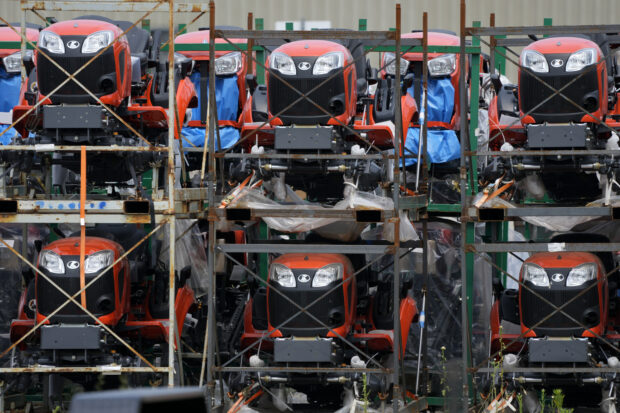US economy likely slowed in April-June quarter but still showed its resilience

Kubota tractors are stored in Uniontown, Pa., Friday, June 9, 2023. On Thursday, the Commerce Department issues its first of three estimates of how the U.S. economy performed in the second quarter of 2023. (AP Photo/Gene J. Puskar)
WASHINGTON — The most aggressive streak of Federal Reserve interest rate hikes in 40 years has slowed the U.S. economy. But to the surprise of many, it hasn’t derailed it.
The economy’s resilience has been on display for months, and on Thursday the government could provide another encouraging snapshot: Its first estimate of growth in the April-June quarter is expected to show that the gross domestic product — the economy’s total output of goods and services — expanded at a modest 1.5 percent annual rate, according to a survey of forecasters by the data firm FactSet.
A pace of roughly that size would reflect a continuing slowdown from a 2-percent growth rate in the January-March quarter, 2.6 percent for the October-December period and 3.2 percent for July through September of last year. But it would still point to consistent growth.
READ: US economic growth slowed in Q1 as businesses draw down inventories
In fighting inflation, which last year hit a four-decade high, the Fed has raised its benchmark rate 11 times in 17 months, most recently on Wednesday. The resulting higher borrowing costs for a broad range of loans — from mortgages and credit cards to auto loans and business borrowing — have taken a toll on growth. But they have yet to tip the United States into a widely forecast recession.
Optimism has been growing that a recession isn’t coming after all, that the Fed can engineer a so-called “soft-landing” — slowing the economy enough to bring inflation down to its 2 percent annual target without wrecking an expansion of surprising durability.
READ: Fed staff drop US recession forecast, Powell says
This week, the International Monetary Fund upgraded its forecast for U.S. economic growth for all of 2023 to 1.8 percent. Though that would be down from 2.1 percent growth for 2022, it marked an increase from the 1.6 percent growth that the IMF had predicted for 2023 back in April.
At a news conference Wednesday after the Fed announced its latest quarter-point rate hike, Chair Jerome Powell revealed that the central bank’s staff economists no longer foresee a recession in the United States. In April, the minutes of the central bank’s March meeting had revealed that the Fed’s staff economists envisioned a “mild” recession later this year.
In his remarks, Powell noted that the economy has proved resilient despite the Fed’s rapid rate hikes. And he said he still thinks a soft landing remains possible.
“My base case is that we will be able to achieve inflation moving back down to our target without the kind of really significant downturn that results in high levels of job losses,” the Fed chair said.
By any measure, the American job market has shown itself to be remarkably strong. At 36 percent in June, the unemployment rate hovers just above a five-decade low. A surge in retirements after COVID-19 hit in early 2020 has contributed to a shortage of workers across the country, forcing many companies to raise wages to attract or keep staffers.
READ: US economy still churning out jobs at brisk clip; wage pressures subsiding
Higher pay and job security are giving Americans the confidence and financial wherewithal to keep shopping. Indeed, consumer spending, which drives about 70 percent of economic activity, rose at a 4.2-percent annual rate from from January through March, the fastest quarterly pace in nearly two years. Americans have kept spending —crowding airplanes, traveling overseas and flocking to concerts and movie theaters.
And the Conference Board, a business research group, reported Tuesday that Americans this month are in their sunniest mood in two years, based on the board’s reading of consumer confidence.
Indeed, many consumers are finally enjoying some relief from spiking prices: Year-over-year inflation, which peaked at 9.1 percent in June 2022, has eased consistently ever since. Inflation-adjusted hourly pay rose 1.4 percent in June from a year earlier, the sharpest such gain since early 2021.
READ: US consumer prices rise modestly in June; core inflation slowing
Still, the risk remains that the weight of ever-higher interest rates will eventually slow borrowing so much — for homes, cars, renovations, business expansions and other costly expenses — as to pull the economy into recession.
“Consumers are still willing to spend, but they have become increasingly cautious and selective,” said Gregory Daco, chief economist at the accounting and consulting firm EY.
Daco said he expects consumer spending to slow sharply and for annual growth in the April-June quarter to come in at 1.7 percent. He pegs the likelihood of a recession at 50 percent.
Among the economy’s weakest links has been the housing market. In June, sales of previously occupied homes sank to their slowest pace since January. The problem is that a near-historic low number of homes for sale and higher mortgage rates kept many would-be homebuyers on the sidelines. Sales fell 19 percent compared with June 2022 and were down 23 percent through the first half of the year.